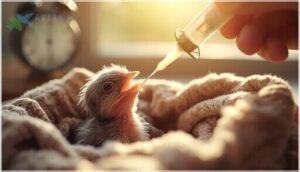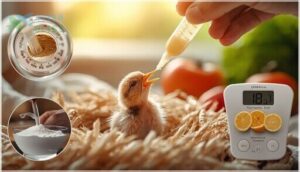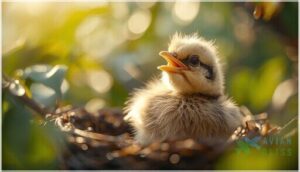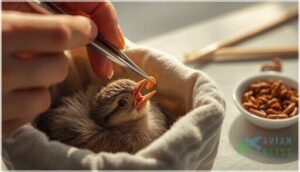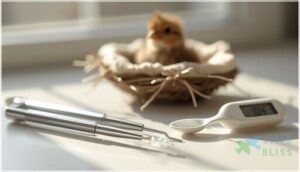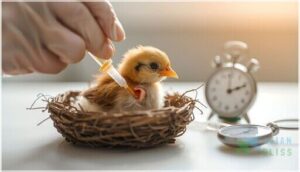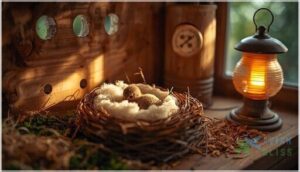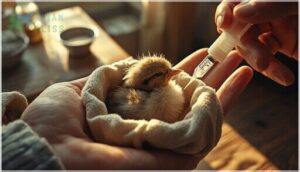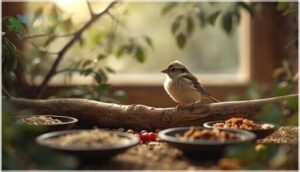This site is supported by our readers. We may earn a commission, at no cost to you, if you purchase through links.
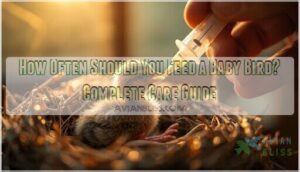
Most hatchlings need food every 15 to 30 minutes from sunrise to sunset, a pace that slows as they grow. The species matters too. A sparrow’s needs differ from a robin’s, and a parrot chick operates on an entirely different clock. Understanding these rhythms means the difference between a thriving fledgling and one that struggles to gain weight or develop properly.
Table Of Contents
- Key Takeaways
- Caring for Baby Birds
- How Often to Feed Baby Birds
- Feeding Schedule for Baby Birds
- Nutritional Needs of Baby Birds
- Signs of Proper Feeding and Growth
- Feeding Techniques for Baby Birds
- Creating The Ideal Environment
- Hand-Feeding Baby Birds
- Common Concerns and Solutions
- Long-Term Care for Baby Birds
- Frequently Asked Questions (FAQs)
- How often do baby birds eat?
- How often should a bird eat?
- How to feed a baby bird?
- How often should I Feed my Baby?
- How often should new hatched birds eat?
- How often should I Feed my new hatched chicks?
- How long should you wait between feeding a baby bird?
- How to feed baby birds?
- How often do fledgling birds eat?
- How many eggs can one eat per week?
- Conclusion
Key Takeaways
- Baby birds need feeding every 15-30 minutes during daylight hours when newly hatched, with intervals gradually extending to 2-3 hours for nestlings and 4-6 hours for fledglings as they develop feathers and gain weight.
- Always check that the crop—the translucent pouch on the bird’s neck—has emptied completely between feedings to prevent dangerous crop stasis, and never force-feed when the crop still appears full.
- Formula temperature must stay between 102°F and 106°F, mixed at roughly 10% of the bird’s body weight per feeding, with daily weight monitoring to catch problems early and adjust portions as the bird grows.
- Most “abandoned” fledglings don’t actually need rescue since their parents are nearby, and federal law prohibits keeping native wild birds beyond 24 hours without proper permits—contact licensed wildlife rehabilitators who achieve 79% release rates.
Caring for Baby Birds
Before you can focus on feeding schedules, you need to make sure the baby bird has a proper setup. The right environment keeps the bird safe, warm, and stress-free while you care for it.
Let’s cover the three main things you need to get right from the start.
Choosing The Right Environment
To be sure, when setting up a safe environment for your baby bird, think of yourself as an architect designing a tiny recovery room. The brooder setup you create becomes the foundation for survival.
Temperature control isn’t negotiable. Featherless hatchlings need a consistent 95°F–97°F, while those with pinfeathers can tolerate 75°F–85°F. Use a reliable thermometer to monitor this constantly.
Your brooder setup checklist should include:
- Soft, non-slip nesting material like clean towels to prevent leg injuries
- Humidity levels above 50% to support healthy growth and breathing
- A secure bird enclosure that keeps out pets and other threats
- Proper ventilation without drafts that could chill your patient
Location safety matters more than you’d think. Place the brooder in a quiet, draft-free spot away from direct sunlight and household traffic. This safe place provides predator protection while maintaining the stable conditions your bird needs to thrive. Daily cleaning keeps the space hygienic and comfortable. To support healthy development, consider the importance of proper temperature maintenance.
Handling Orphaned Birds Safely
Once you’ve got your brooder ready, handling comes next—and doing it right protects both you and the bird.
Always wear gloves when picking up orphaned birds. Up to 72% of wildlife rehabilitators use them to prevent zoonotic risks like Salmonella. Wash your hands thoroughly after every contact, especially if kids are around.
Keep handling brief—under two minutes—for stress reduction. Longer sessions increase mortality risk by 15% in nestlings.
Here’s your quick reference:
| Bird Type | Action Needed |
|---|---|
| Nestling (featherless) | Return to nest if possible |
| Fledgling (feathered) | Observe from distance; parents nearby |
| Injured/bleeding | Contact wildlife rehabilitation centers immediately |
For safe transport to wildlife rescue, use a ventilated shoebox lined with soft towels. This simple setup cuts feather damage by 40% and prevents injury during the trip.
Federal law prohibits keeping native birds beyond 24 hours without proper permits—legal aspects matter when caring for abandoned baby birds. Licensed rehabilitators achieve 79% release rates, while unauthorized handrearing baby birds often ends badly. Many states consider it illegal to raise a wild bird without proper licensing.
If you’re unsure whether intervention is needed, watch first. Over 85% of “abandoned” fledglings don’t actually need rescue—their parents are watching nearby.
Providing a Safe and Comfortable Space
Now that you’ve handled your orphaned bird safely, it’s time to set up proper baby bird housing.
Start with an enclosure design that matches your bird’s size. Small species like budgies need at least 18″ x 18″ x 24″, while larger birds require bigger dimensions.
Your brooder setup should include:
- Non-slip bedding materials like pine shavings or soft towels, at least a few centimeters deep
- Temperature control maintaining 95-97°F for featherless hatchlings using a heating pad
- Daily hygiene practices—clean droppings and food bowls, with weekly deep disinfection
- Predator protection through secure locks and strategic placement away from pets
- Adequate ventilation using 1/2 to 3/4 inch mesh for proper airflow
Choose enclosure materials that are natural and non-toxic. Avoid chemically treated options that cause respiratory problems.
How Often to Feed Baby Birds
Once you’ve got the environment sorted, feeding becomes your main focus. Baby bird feeding schedules aren’t one-size-fits-all—they depend heavily on age.
Hatchling nutrition is intense. Those first few days, you’re looking at feedings every 2-3 hours during daylight—roughly 6-10 times daily. Some songbirds need food even more often, closer to every 30 minutes. At this stage, you can’t skip feedings or let feeding intervals stretch past two hours without risking their health.
Hatchlings demand feedings every 2-3 hours during daylight—some songbirds every 30 minutes—and skipping meals risks their survival
Key feeding frequency guidelines:
- Hatchlings (under 1 week): Every 2-3 hours, sometimes every 30 minutes for certain species
- Nestlings (1-2 weeks): Every 2-3 hours, 8-10 times daily
- Fledglings (older, feathered): Every 4-6 hours as they move toward independence
Nighttime feedings usually stop after the first week. Overfeeding risks are real—forcing food when the crop hasn’t emptied can cause serious problems. Always check that previous meals have digested before offering more.
Feeding Schedule for Baby Birds
Getting the feeding schedule right can feel like a puzzle at first, but it’s simpler than you might think. The key factors are how often you need to feed, how much formula to offer at each feeding, and when to start introducing solid foods.
Let’s break down each piece so you can create a routine that keeps your baby bird healthy and growing strong.
Frequency of Feedings
Your baby bird feeding schedule depends entirely on age. Newly hatched chicks need feeding every 15–30 minutes during daylight hours—up to 10 times daily. That’s because their tiny crops can’t hold much, and their metabolism runs hot.
Once their eyes open around week one, you can stretch feeding intervals to every 3–4 hours. By weeks two to three, aim for every 4–6 hours as feathers emerge.
Species variations matter too—parrots under three days old often need six daily feedings, while songbirds may demand 30–40. Always monitor your bird’s crop between feedings to avoid overload.
Amount of Formula to Feed
Each feeding requires careful calculation based on your bird’s exact weight. You’ll want to provide roughly 10% of their body weight per feeding—that’s about 5 milliliters for a 100-gram chick. Formula dilution matters too: mix one part powder to three parts water for most young birds.
Here’s what you need to track:
- Weigh your bird daily with a gram-accurate scale to adjust dosage
- Check crop fullness after each feeding—it should look full but not stretched tight
- Monitor species differences since parrots may need up to 15% body weight per feed
Watch for slow crop emptying between feedings. That signals you’re giving too much. Weight monitoring tells you when dosage adjustment is needed for healthy growth.
Transitioning to Solid Foods
When your bird starts showing interest in what you’re eating, that’s nature’s way of saying it’s time to introduce solid foods. Most baby birds reach this weaning point between 3 and 4 weeks old, though larger parrots may wait until 12-16 weeks. The food introduction age depends heavily on species—cockatiels start at 6-7 weeks while smaller songbirds begin earlier.
Watch for these readiness indicators during the weaning period:
- Pecking at food bowls or exploring nearby objects with their beak
- Fully opened eyes and complete feather coverage
- Active, curious behavior around mealtime
- Soft droppings containing visible food particles
Start with moistened pellets and soft vegetables alongside formula. Your feeding schedule gradually shifts as solid food intake increases, usually over 2-6 weeks.
Nutritional Needs of Baby Birds
Getting the nutrition right can mean the difference between a thriving baby bird and one that struggles to survive. You can’t just toss any food into the box and hope for the best—these little ones need specific formulas mixed at the right consistency, prepared safely, and offered at the proper temperature.
Let’s walk through how to choose, prepare, and provide what your baby bird needs to grow strong.
Choosing The Right Formula
You’ll find the best commercial baby bird formulas offer species-specific nutrition adapted to your little one’s needs. Look for options like Kaytee Exact, Harrison’s Juvenile, or Higgins inTune, each designed with precise protein levels (21-25%) and fat content (5-20%) your bird requires. Check that vitamin inclusion covers A, D3, and E—essentials for healthy growth.
Choosing the wrong formula carries real risks, from nutritional deficiencies to developmental delays, so consulting an avian vet makes sure you’re meeting your bird’s exact nutritional needs.
Preparing The Formula
Getting the formula preparation right can mean the difference between a thriving chick and a struggling one. Formula temperature should sit between 102°F and 106°F—use a thermometer to check before every feeding. Testing a drop on your wrist helps, but don’t rely on feel alone.
Your mixing ratios matter just as much. Start young nestlings on a thinner consistency, around 1:3 (formula to water), then gradually thicken it as they grow. Think smooth applesauce, not pancake batter.
Sterilization methods protect your bird from infections:
- Boil feeding syringes in water for 5-10 minutes
- Use steam sterilizers between feedings
- Try chemical disinfectants like Milton tablets
- Never reuse unsterilized equipment
Mix only what you’ll use immediately, and toss any leftovers. Safe dilution and proper food consistency aren’t just guidelines—they’re your bird’s lifeline.
Providing Water for Baby Birds
Water might seem like basic care, but it’s surprisingly tricky with baby birds. Most nestlings get all their hydration through formula—they don’t need direct water at all. Natural hydration sources work best at this stage, mimicking what parent birds provide.
When you do offer water to older fledglings, use shallow dishes and watch for water aspiration risks. Never force water into their beaks. Dehydration signs include sunken eyes, dry skin, and lethargy, but species water needs vary.
Hand-fed chicks need their formula mixed correctly to prevent dehydration symptoms. Your safest approach? Stick with properly diluted formula and let fledglings discover water on their own terms.
Signs of Proper Feeding and Growth
When you’re raising a baby bird, you need to watch for signs that your care is working. Healthy growth shows up in steady weight gain, active behavior, and a bird that eagerly eats at feeding time.
Here’s what to look for to make sure your feathered friend is thriving.
Monitoring Weight and Behavior
Every morning before that first feeding, you’ll want to step into your role as the growth tracker your baby bird depends on. Weight monitoring becomes your early-warning system, revealing what’s working and what needs adjustment. Use a digital gram scale—kitchen or postal scales work perfectly—and record the numbers daily. Healthy chicks generally gain 10-15% of their body weight each day during rapid growth phases, with weight fluctuations of 1-2 grams being completely normal.
Watch for these behavioral indicators of well-being:
- Alert, responsive reactions to your presence and feeding cues
- Active stretching, hopping, and wing-flapping between meals
- Relaxed posture with fluffed feathers after feeding
- Steady vocalizations that quiet down when content
Growth patterns tell the real story. Your consistent weighing methods help you catch feeding frequency issues before they become serious problems.
Recognizing Health Issues
After tracking growth and behavior, sharp eyes help you spot baby bird health issues before they snowball. Watch for subtle shifts—like a chick that’s fluffing up, breathing oddly, or refusing food. Odd droppings or twitchy movements can wave a red flag for gastrointestinal signs or neurological issues.
Here’s a cheat sheet you’ll want to keep:
| Symptom | Possible Issue | What to Watch For |
|---|---|---|
| Fluffed feathers | Respiratory distress | Labored or open-mouth breathing |
| Abnormal droppings | Gastrointestinal signs | Unusual color, texture, or frequency |
| Head tremors | Neurological issues | Shaking, loss of balance |
| Swollen eyelids | External symptoms | Redness, discharge, or irritation |
| Lethargy | Behavioral changes | Less activity, poor response to you |
When to Seek Veterinary Assistance
Some symptoms demand immediate action—don’t wait to see if they pass. If your baby bird breathes rapidly (over 60 breaths per minute), gasps with an open mouth, or shows signs of bleeding, you’re facing emergency symptoms that need urgent veterinary care. Common injuries like fractures, deep wounds, or eye trauma also require prompt attention from an avian specialist.
Growth plateaus matter too. If your chick isn’t gaining weight or shows delayed feathering, something’s off. Toxin ingestions from household chemicals or infectious diseases can spiral fast—often within 24 to 48 hours.
When health issues pop up, trust your gut. A qualified veterinarian can diagnose problems early and improve your bird’s chances of recovery.
Feeding Techniques for Baby Birds
Getting food into a baby bird’s mouth safely takes more finesse than you might think. The tools you use and the way you deliver each bite can mean the difference between a thriving nestling and a bird at risk for choking or injury.
Let’s walk through the right equipment and methods to keep feeding time both safe and effective.
Using Tweezers or Chopsticks
Using tweezers or chopsticks might feel awkward at first, but these tools are your best friends when feeding nestlings and fledglings. Wildlife rehabilitation centers rely on this grip technique because it allows precise food placement without injuring delicate beaks.
Here’s what you need to know:
- Hold your tweezers at a 45-degree angle to the beak for beak safety
- Wait patiently for the bird to gape (open wide) before inserting food
- Tool sterilization matters—wash tools between each feeding session
- Species variation affects technique; smaller birds need gentler handling
- Chopsticks work well for larger fledglings, while fine-tipped tweezers suit tiny nestlings
These feeding methods beat syringe feeding for delivering insects and soft foods naturally.
Feeding Tools and Techniques
Beyond tweezers and chopsticks, your feeding kit needs the right tools for different situations. Syringe feeding works best for formula delivery—start with a 1cc syringe for newborns, then move to 3cc as they grow. Syringe control prevents aspiration, so feed slowly from the side of the beak.
Here’s your essential toolkit:
- Sterilize syringes, spoons, and pipettes between each feeding using diluted vinegar or bird-safe disinfectants
- Test formula temperature (102-106°F) before every feeding to avoid burns
- Make species adjustments for diet and tool size as your bird develops
Hygiene protocols aren’t optional—they’re lifesaving.
Avoiding Overfeeding
Because crop distension can happen fast, you need to check the crop before every feeding—it should feel soft, not hard or bulging. Stick to preventative protocols: feed only 10-12% of body weight per session, and space feeding times based on crop emptiness.
Watch for regurgitation signs and abnormal fecal output, which signal you’re overdoing it. Weight monitoring helps too—sudden jumps mean you’re pushing too much food.
Adjust your feeding frequency and feeding amount as the bird matures to avoid overfeeding complications.
Creating The Ideal Environment
A baby bird’s surroundings can make or break its recovery. You’ll need to think about where you place the enclosure and how you control the temperature and humidity inside it.
Let’s look at the two main factors that will keep your little patient comfortable and thriving.
Choosing The Right Location
Where you place your baby bird can make the difference between thriving and struggling. You need an indoor space that checks every box for safety and comfort.
Start by scoping out a quiet room away from household traffic. Your baby bird needs calm to focus on growing, not constant stimulation. Here’s what to look for when creating the ideal environment:
- Choose a spot away from windows where outdoor predators like hawks might stress the bird
- Keep the area far from kitchen fumes and strong cleaning products for proper Ventilation Needs
- Position the enclosure where pets can’t reach it—Predator Avoidance starts at home
- Select a location with minimal noise (under 50-60 dB) for Noise Reduction
- Confirm adequate Space Requirements with room for the bird to move safely
Providing a safe and comfortable space means thinking like a wildlife rehabilitator from day one.
Maintaining Temperature and Humidity
Getting the temperature right isn’t guesswork—it’s survival. Your baby bird needs Ideal Temperatures between 95-97°F for hatchlings, gradually decreasing as feathers develop. Use a heat lamp or Brooder Devices with a thermometer for precise control, Preventing Hypothermia that stunts growth.
Humidity Monitoring matters too—aim for 55-70% initially to prevent dehydration. A Humidity Imbalance invites respiratory trouble, so check levels daily with a hygrometer while Caring for Baby Birds properly.
Hand-Feeding Baby Birds
Hand-feeding a baby bird isn’t something you’ll take on lightly—it requires commitment, patience, and the right approach to keep the bird safe. Knowing when to start, how to prepare your setup, and how to help the bird eventually feed itself are all part of the process.
Let’s walk through each step so you can give your little one the best chance at a healthy start.
When to Start Hand-Feeding
Timing is important for handfeeding baby birds. You’ll want to start around 2 to 3 weeks of age, once your bird shows clear physical signs like feather growth and behavioral cues such as gaping or head-bobbing. Species variation affects this timeline, so watch for hunger signals and age milestones to nail your feeding schedule and set the stage for proper weaning readiness.
Key indicators you’re ready to begin:
- Your baby bird eagerly gapes its mouth when you gently touch the corners
- Tiny feathers are sprouting and eyes have opened fully
- Peeping or begging sounds fill the air whenever you approach
- The little one’s crop empties properly between feeding times
Preparing for Hand-Feeding
Before you start handfeeding, hygiene preparation matters more than you’d think. Wash feeding equipment with hot, soapy water, then soak it in avian disinfectant to kill bacteria.
Mix your formula to 102°F–106°F and check it with a thermometer—too hot burns, too cold slows digestion. Keep your syringe, gram scale, and brooder thermometer ready.
Formula consistency should match your chick’s age: watery for hatchlings, thicker as they grow.
Transitioning to Independent Feeding
Once your chick is halfway feathered, you can start the weaning process by offering solid foods alongside formula. This is where weaning benchmarks really matter—Amazon Parrots wean around 12 weeks, while Cockatiels can start at just 6–7 weeks.
Gradually reduce your feeding schedule from 3–4 daily feedings down to one as your bird shows interest in self-feeding:
- Place crumbled pellets and cooked veggies in easy reach
- Keep food and water available at all times
- Skip a feeding if your bird refuses formula
- Track weight daily—a 10% drop is normal, but more signals trouble
- Watch droppings for solid food particles
Weight monitoring helps you catch problems early. Most birds refuse formula for two weeks before they’re fully weaned.
Common Concerns and Solutions
Even when you’re doing everything right, baby birds can throw you a curveball. Sometimes they refuse to eat, or you’ll notice signs that something’s off with their health.
Let’s walk through the most common hiccups you might face and how to handle them calmly and effectively.
What to Do if The Baby Bird Refuses to Eat
When your baby bird won’t eat, start by checking for refusal causes like dehydration or crop stasis. Try rehydration methods first—a few drops of warm electrolyte solution can help.
Make environmental adjustments by keeping the temperature around 27–32°C and reducing stress from noise or bright light.
Use feeding stimulation techniques like offering warm, moist foods or applying fruit puree to the beak to trigger feeding cues.
If feeding refusal persists beyond 12 hours, seek veterinary assistance immediately, as appetite stimulants or professional interventions may be needed after recognizing signs of illness.
How to Deal With Health Issues
When your baby bird refuses food for several hours, recognizing signs of illness becomes critical. Check for crop stasis, respiratory distress, or malnutrition signs like fluffed feathers and lethargy.
Watch for these baby bird symptoms:
- Fungal infections showing white patches in the mouth
- Labored breathing or wheezing
- Dehydration requiring fluid administration
- No droppings for extended periods
Seek baby bird veterinary care immediately if health issues persist beyond 24 hours.
Long-Term Care for Baby Birds
As your baby bird grows stronger and more independent, you’ll need to shift your focus from intensive hand-feeding to preparing it for life on its own. This shift involves gradually introducing natural foods, creating a proper living space, and helping the bird develop essential survival skills.
Let’s look at the key steps you’ll need to take during this important phase.
Introducing Natural Foods
Once your fledgling reaches the 13- to 20-day mark with open eyes and full feathers, it’s time to introduce natural foods. This food introduction timing helps your baby bird develop the skills it needs for independence.
Start your baby bird diet with soft options like finely chopped mealworms, caterpillars, and mashed hard-cooked eggs. These natural food types provide essential protein for healthy growth. Follow safe introduction protocols by keeping initial portions to 20% of the diet, then gradually increase as your bird adapts.
Watch for common feeding challenges like refusal to eat or digestive upset. Remember, proper baby bird feeding with natural foods improves survival rates and readies your bird for release into the wild.
Providing a Suitable Enclosure
As your bird grows, Providing a Suitable Enclosure becomes essential for long-term health. Creating The Ideal Environment means choosing safe materials like stainless steel or powder-coated cages—never galvanized metal or wood.
Your brooder or box should offer adequate Enclosure size (at least 1.5 times the wingspan), proper Design complexity with varied perches, and Liner safety using paper towels changed daily.
Temperature control and Providing a Safe and Comfortable Space support healthy development.
Ensuring a Smooth Transition to Independence
Once your bird reaches 6–12 weeks, the weaning process begins. Gradually reduce feeding schedules for baby birds—Amazon parrots generally wean around 12 weeks, cockatiels at 6–7 weeks. Introduce natural foods like insects and soft fruits while monitoring weight daily. Provide branches for Flight Performance practice and Habitat Acclimation. This strengthens Behavioral Development and Socialization Skills, preparing fledglings for independence.
| Weaning Step | Age Range | Key Actions |
|---|---|---|
| Start reducing feedings | 6–8 weeks | Offer seeds, mealworms |
| Increase self-feeding | 8–10 weeks | Monitor weight daily |
| Flight practice begins | 10–12 weeks | Add perches, branches |
| Full independence | 12+ weeks | Prepare for release |
Frequently Asked Questions (FAQs)
How often do baby birds eat?
Like clockwork, nestlings demand attention constantly—feeding intervals run every 15-20 minutes during daylight hours for the youngest birds.
As development stages progress, feeding frequency drops to 2-3 times daily for fledglings gaining independence.
How often should a bird eat?
Your feeding schedule depends on age and development stage. Nestlings need food every 15-20 minutes during daylight hours. As they grow, extend feeding intervals to 2-3 hours, then gradually space feedings further apart.
How to feed a baby bird?
Proper positioning prevents problems—tilt the syringe gently into the beak’s side to avoid the trachea.
Keep your formula temperature at 104°F, monitor the crop carefully, and master feeding techniques for successful weaning.
How often should I Feed my Baby?
Your feeding schedule depends on your bird’s age. Hatchlings need meals every 15-20 minutes from sunrise to sunset. Nestlings eat every 20-45 minutes during daylight. Fledglings require feeding times just 3-5 times daily.
How often should new hatched birds eat?
Newly hatched birds need feeding every 15 to 20 minutes during daylight hours.
Their tiny bodies have sky-high metabolic rates, especially in cooler environments, making frequent feeding times critical for survival and healthy growth.
How often should I Feed my new hatched chicks?
Your newly hatched chicks need feeding every 2-3 hours during daylight—roughly 6-10 times daily. This frequent schedule fosters rapid growth and prevents nutritional deficiencies while matching their natural feeding rhythms and hatchling development stages.
How long should you wait between feeding a baby bird?
During the day, aim for feeding intervals of 2-3 hours to prevent metabolic impacts and tissue damage. Longer waits risk fasting consequences.
As baby birds mature, you can gradually extend the feeding schedule.
How to feed baby birds?
Feeding baby birds isn’t for the birds—it requires precision. Use a soft-tipped syringe at a 45-degree angle, keep formula warm (102-106°F), and sterilize feeding tools after each session to prevent infections.
How often do fledgling birds eat?
Fledglings eat less often than nestlings—usually every 2-3 hours as they develop their feathers and strength.
Feeding frequency depends on species variations and environmental impact, with older birds gradually moving to independent feeding schedules.
How many eggs can one eat per week?
This question refers to human dietary guidelines, not baby bird care. Most healthy adults can safely consume up to seven eggs per week, though individual variability in cholesterol response and overall dietary context matter for heart health.
Conclusion
An ounce of prevention is worth a pound of cure—especially when a baby bird’s life depends on your vigilance. Now that you know how often to feed a baby bird, watch that crop empty, track those weight gains, and trust your instincts when something feels off.
Every meal you time correctly builds stronger wings. Every health concern you catch early saves a life. You’ve got the knowledge. Now give that little one the future it deserves.
- https://vcahospitals.com/know-your-pet/hand-feeding-baby-birds
- https://www.merckvetmanual.com/management-and-nutrition/management-of-the-neonate/care-of-orphaned-native-birds-and-mammals
- https://www.facebook.com/PoconoWildlife/posts/baby-birds-get-fed-every-15-30-minutes-depending-on-species-and-age-not-all-bird/902716791900146/
- https://wildlifeincrisis.org/environmental-education/primary-care-for-young-birds/
- https://www.futurepets.com/trivia/birds-handfeeding.htm


